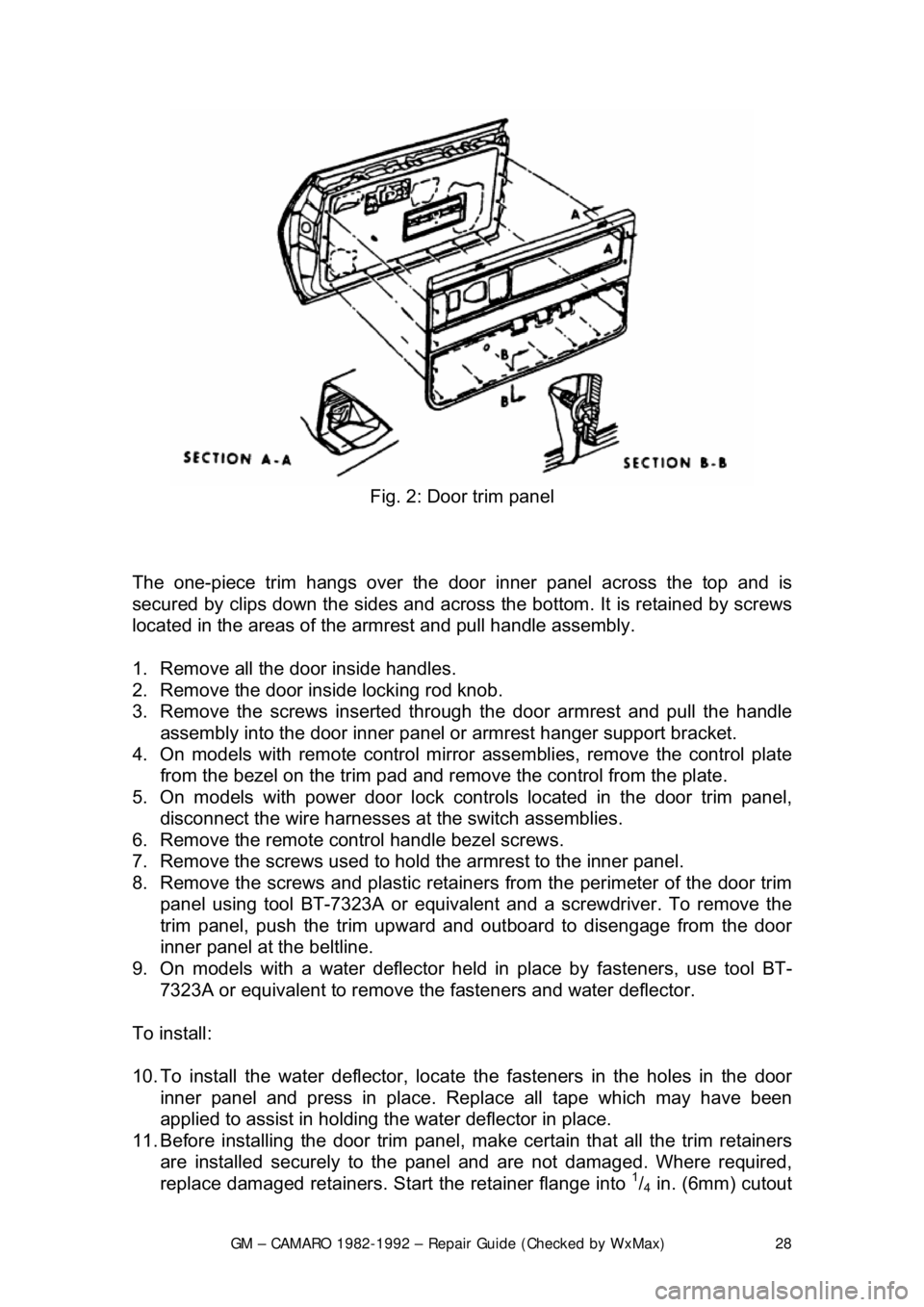1982 CHEVROLET CAMARO remote control
[x] Cancel search: remote controlPage 13 of 875

GM – CAMARO 1982-1992 – Repair Guide (Checked by WxMax) 13
15. Install the spare tire assembly.
16. Install the rear left, ri
ght and center trim panel.
17. Close the rear compartment hatch.
18. Connect the negative battery cable.
OUTSIDE MIRRORS
REMOVAL & INSTALLATION
STANDARD MIRRORS
Fig. 1: Outside mirrors
1. Remove the door trim panel and det ach inner panel water deflector enough
to gain access to the mi rror retainer nuts.
2. Remove the attaching nuts from the mirror base studs and remove the
mirror assembly from the door.
3. Position the mirror onto the door ma king sure the mirror gasket is properly
aligned on the door outer panel.
4. Install the attaching nuts to the mirror base studs and tighten.
5. Install the inner panel wate r deflector and door trim panel.
REMOTE CONTROL MIRRORS
1. Remove the mirror remote control bezel and door trim panel. Detach the
inner panel water deflector enough to expose the mirror and cable assembly
from the door.
Page 14 of 875

GM – CAMARO 1982-1992 – Repair Guide (Checked by WxMax) 14
2. Remove the mirror base-to-door outer
panel stud nuts, remove the cable
from the clip and remove the mirror and cable assembly from the door.
3. Position the mirror onto the door ma king sure the mirror gasket is properly
aligned on the door outer panel.
4. Install the cable onto the clip and install the mirror base-to-door outer panel
stud nuts. Torque to 72 inch lbs. (8 Nm).
5. Install the inner panel wate r deflector and door trim panel.
6. Install the mirror remote control bezel.
POWER OPERATED MIRRORS
Disconnect the negative battery terminal and, from the door trim panel side,
remove the remote control mirror bezel , release and remove the door panel.
1. Disconnect wire harness connection from t he remote mirror electrical switch.
2. Peel back water deflect or enough to detach the har ness from the retaining
tabs in the door.
3. Remove the mirror base-to-door stud nuts and lift mirror housing and
harness assembly from the door.
To install:
5. feed the mirror harness through the do or along with the mirror assembly.
Install the mirror base-to- door stud nuts and tighten.
6. Connect the mirror wire harness and install the water deflector.
7. Connect the wire harness connection to the remote mirror electrical switch.
8. Install the door panel and install the remote control mirror bezel.
9. Connect the negative battery terminal.
Page 28 of 875

GM – CAMARO 1982-1992 – Repair Guide (Checked by WxMax) 28
Fig. 2: Door trim panel
The one-piece trim hangs over the door inner panel across the top and is
secured by clips down the sides and across the bottom. It is retained by screws
located in the areas of the armrest and pull handle assembly.
1. Remove all the door inside handles.
2. Remove the door inside locking rod knob.
3. Remove the screws inserted through the door armrest and pull the handle
assembly into the door inner panel or armrest hanger support bracket.
4. On models with remote control mirror assemblies, remove the control plate
from the bezel on the trim pad and remo ve the control from the plate.
5. On models with power door lock contro ls located in the door trim panel,
disconnect the wire harnesses at the switch assemblies.
6. Remove the remote control handle bezel screws.
7. Remove the screws used to hold the armrest to the inner panel.
8. Remove the screws and plastic retainer s from the perimeter of the door trim
panel using tool BT-7323A or equivalent and a screwdriver. To remove the
trim panel, push the trim upward and out board to disengage from the door
inner panel at the beltline.
9. On models with a water deflector held in place by fasteners, use tool BT-
7323A or equivalent to remove th e fasteners and water deflector.
To install:
10. To install the water deflector, locate the fasteners in the holes in the door
inner panel and press in place. R eplace all tape which may have been
applied to assist in holding t he water deflector in place.
11. Before installing the door trim panel, make certain that all the trim retainers
are installed securely to the panel and are not damaged. Where required,
replace damaged retainers. St art the retainer flange into
1/4 in. (6mm) cutout
Page 29 of 875

GM – CAMARO 1982-1992 – Repair Guide (Checked by WxMax) 29
attachment hole in the trim panel, rotate the retainer until the flange is
engaged fully.
12. Connect all electrical components where present.
13. To install the door trim panel, locate the top of the assembly over the upper
flange of the door inner panel, inserting the door handle through the handle
slot in the panel and press down on the trim panel to engage the upper
retaining clips.
14. Position the trim panel to the door inner panel so the trim retainers are
aligned with the attaching holes in t he panel and tap the retainers into the
holes with the palm of hand or a clean rubber mallet.
15. Install the screws used to hold the armrest to the inner panel.
16. Install the remote control handle bezel screws.
17. On models with power door lock contro ls located in the door trim panel,
connect the wire harnesses at the switch assemblies.
18. On models with remote control mirror assemblies, install the control to the
plate. Install the control plate to the bezel on the trim pad.
19. Install the handle assemb ly and install the screws inserted through the door
armrest.
20. Install the door inside locking rod knob.
21. Install all the door inside handles.
HEADLINER
REMOVAL & INSTALLATION
Fig. 1: Headliner installation
1. Disconnect the negative battery cable.
2. Remove the dome lamp and sunshade.
3. Remove the coat hooks and seat bel t escutcheon, by unsnapping from the
headliner.
4. Remove the rear window opening molding.
Page 132 of 875

GM – CAMARO 1982-1992 – Repair Guide (Checked by WxMax) 132
Some electrical components which require
a large amount of current to operate
use a special switch called a relay. Sinc e these circuits carry a large amount of
current, the thickness of the wire in the ci rcuit is also greater. If this large wire
were connected from the load to the c ontrol switch, the switch would have to
carry the high amperage load and the fair ing or dash would be twice as large to
accommodate the increased size of t he wiring harness. To prevent these
problems, a relay is used.
Relays are composed of a coil and a se t of contacts. When the coil has a
current passed though it, a magnetic fiel d is formed and this field causes the
contacts to move together, completing the circuit. Most relays are normally
open, preventing current from passing thr ough the circuit, but they can take any
electrical form depending on th e job they are intended to do. Relays can be
considered "remote control switches." They allow a smaller current to operate
devices that require higher amperages. W hen a small current operates the coil,
a larger current is allo wed to pass by the contacts. Some common circuits
which may use relays are the horn, headlight s, starter, electric fuel pump and
other high draw circuits.
Fig. 3: Relays are composed of a coil and a switch. These two components are
linked together so that w hen one operates, the other operat es at the same time.
The large wires in the circuit are connect ed from the battery to one side of the
relay switch (B+) and from the opposite side of the re lay switch to the load
(component). Smaller wires are connected from the relay coil to the control
switch for the circuit and from the opposite side of the relay coil to ground
LOAD
Every electrical circuit must include a "load" (something to use the electricity
coming from the source). Without this l oad, the battery would attempt to deliver
its entire power supply from one pole to another. This is called a "short circuit."
All this electricity would take a short cut to ground and cause a great amount of
damage to other components in the circui t by developing a tremendous amount
of heat. This condition could develop suffici ent heat to melt the insulation on all
the surrounding wires and reduce a multiple wire cable to a lump of plastic and
copper.